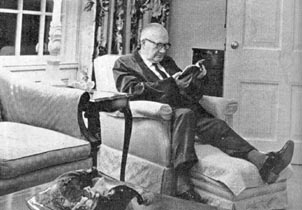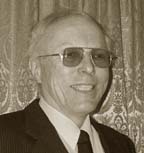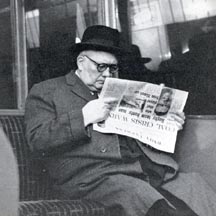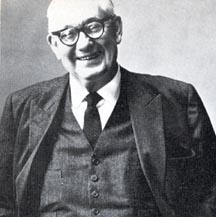 |
|
|
|
from Russell Braddon:
Roy
Thomson of Fleet Street, London, 1965.
|
 |
|
|
|
from Russell Braddon:
Roy
Thomson of Fleet Street, London, 1965.
|
This page was set up by Robert Sewell in February 2002 to show the relationship of the Family of Lord Thomson of Fleet to the Family of David Thomson and Mary Glendenning who were original settlers in Scarborough, Ontario, Canada. Robert Sewell is not a Thomson descendant. His grandmother's sister, Irene Furse, married William Richard Thomson. Their son Lionel Thomson had in his possession a Thomson Genealogy from which this web site has been copied. Click on Thomson Genealogy to go directly to this work.
 Robert Sewell graduated from McMaster University (Hamilton, Ontario, Canada)
in 1967 with a B.Sc. degree in chemistry. After a year of studies
at the University of Toronto's College of Education, he taught high school
science in Collingwood, Ontario for a year and then taught chemistry, physics
and general science in Hamilton, Ontario for twenty-nine years. Robert
Sewell retired from teaching in June 1998. He may be contacted by
email from September to May at the following address:
Robert Sewell graduated from McMaster University (Hamilton, Ontario, Canada)
in 1967 with a B.Sc. degree in chemistry. After a year of studies
at the University of Toronto's College of Education, he taught high school
science in Collingwood, Ontario for a year and then taught chemistry, physics
and general science in Hamilton, Ontario for twenty-nine years. Robert
Sewell retired from teaching in June 1998. He may be contacted by
email from September to May at the following address:
Please visit the Sewell Genealogy Site Map for other pages in this series.
Roy Thomson of Fleet Street
(The following is an excerpt from Russell Braddon: Roy Thomson of Fleet Street, London, 1965.)
Heredity, some say, contributes most to man’s character: and according to them, one must, when studying a Thomson, take most into consideration an ancestry that is Scottish — and all that such a past implies.
Local historians relate that the Thomsons of Eskdale, with whom we are concerned (not to be confused with any Thompsons with a “p,” who are not Scottish at all, but English and contemptible) were a small fifteenth-century clan, obeying the call of the larger clan Beattison, mostly for raids across the border.
Not that the Thomsons lacked initiative or needed leading into mischief. In 1504, John Thomson of Bonese was fined £10; another Thomson, for crimes that ranged allegedly from sheep-stealing to treason, was hanged; and the entire Thomson clan were skilled horsemen who, although temperate and delighting in music, knew their way round the misty marshes of the frontier so well that to pursue them for their crimes was almost pointless.
“The Batysons and Thomsons of Eskdale,” England’s Lord Wharton reported sourly, “have burnt a town called Grange, with all the corn therein, and brought away nolt and other goods amounting to eche of them in their dividing 8 shillings.”
Later: “The Batysons, Thomsons and Lytles of Esskdayle, Ewesdaill and Wacopdale” — Lord Wharton’s spelling of place names in the 1540’s was as contemptuously inconsistent as T. E. Lawrence’s was to be some 380 years later — “burnt a town on the Water of Dryff called Blendallbush, and brought away 16 oxen and keyne, some naggs with all the insight of the town.”
Considering this constant drain of all his territory’s corn, nolt, oxen, keyne, naggs, insights and other forms of “boutie”, it must be allowed that Lord Wharton’s reports were admirably objective. But then, Lord Wharton knew what he was doing.
In 1544 he invaded Scotland and not only brought the clans ruthlessly to heel, but even persuaded some of them, under a English assurance, to transfer their predatory attentions from the southern to the northern side of the Border. Thereafter the Beattisons and Thomsons, as energetically as ever, raided not the English but the Scots.
“Hundrethe of the Batysons of Eskdaill and the Thomsons,’ Wharton subsequently advised the Earl of Shrewsbury, “brent town called Fastheughe, taking away all the insight, certain naggs and fiftie nowte.”
Amiably taking up a suggestion of Wharton’s, the same two clans attacked Branxholme and Mosshouse, “smoked very sore the towers,” slew many Scots and then, crowning all their ravages, “wanne a tower of the Captains of Edinburgh Castle, called Burdlands, burnt all the roofs within the walls, and coming home took many oxen and shepe beside one Scott slayne.”
But by the end of the sixteenth century authority on both sides of the border was impatient with the lawlessness of the raiding clans, assurances of good conduct being required from all of them: and when old habits died hard, many were caught and hanged as rebels — Thomsons among them.
Presumably such hangings had their deterrent effect, because the Thomson family soon vanished from the records of those days and were not heard of again until 1679, when the Buccleuch rent books reveal their presence as tenants of the smallest farms in the district.
Times were not good, however, for farming. In 1681 a wickedly dry summer was followed by a wickedly cold winter. During the “Thirteen Drifty Days” of 1684, pitiless snow storms wiped out ninety per cent of all the sheep in the district, those that survived being kept alive only by the walls of dead sheep built around them by their shepherds.
The winters of 1740, 1746 and 1755 were calamities spoken of with horror for years afterwards. The summer of 1756 was one of severe drought aggravated by a plague of green caterpillar grubs which destroyed all the grass in the district, cutting it away at the roots. And in 1763 frost and snow killed more than a third of the local flocks.
All of which
is perhaps the reason why Andrew Thomson, in the first third of the eighteenth
century, chose to be a stone mason and not a farmer; and why Archibald,
the second of his seven children, father of a large family and master carpenter,
decided to emigrate with his family to Canada in 1773.
In 1796 Archibald’s two younger
brothers, David and Andrew1
, accepting his advice, followed him to North America, where all three
built homesteads in the same street of the town York2
, later re-named Toronto.
Surprisingly,
neither David nor Andrew prospered as the much older Archibald had. Also
Archibald’s youngest son, George, married and had ten children, one of
who, Hugh, was born in 1834.
This Hugh (who married a girl called
Mary, from Markham, and by her had three children, all boys) has not been
treated kindly by word of mouth, and there are no documents to disprove
the rumours about him. Allegedly, though by trade he was a harness maker,
he was a gambler and a drinker and a rolling stone—even, some say, a card-sharper
and a confidence man.
Fecklessly he took his wife and three small sons to New York and there, even more fecklessly, he either died or decamped. Whichever it was, he left his wife penniless; and she, wasting no time on self-pity, herded her young family back to the one place where she knew people, which was Markham, in Canada.
There, for a while, she supported her three sons by needlework and dressmaking. Then a widower called William Pethick, with two sons of his own, married her and took her to Bowmanville; and by him she had three more children.
Meantime Herbert, her youngest son by her first marriage, had met a strong, red-cheeked English girl who worked at the hotel near Bowmanville railway station. Her name was Alice Coombs, and she had been brought out from Bath by her aunt, Mrs. Hislop, who owned the hotel.
So Herbert, who was a barber, and Alice, who was a hotel maid, married in 1893 and moved into a Toronto house which Mrs. Hislop — a shrewd dealer in second mortgages — made available to them. The house was in Monteith Street3 , a cramped cul-de-sac in mid-town Toronto: and into this house, on 5th June, 1894, was born a son — Roy Herbert Thomson — descendant of border raiders, ruined farmers, hard working artisans, elderly migrants, a ne’er do well grandfather, a strong-minded grandmother and an even stronger-minded mother.
If the influences of heredity are important in the creation of character, the infant Roy stood equal chances of becoming a distinguished Canadian, like his great-great-grandfather Archibald; or an inconspicuous Canadian like his great-grandfather George; or a drunken Canadian like his grandfather Hugh; or a barber like his father; or a mother’s boy; or an opportunist buccaneer like his fifteenth-century forebears; or even a corpse dangling from a hangman’s noose, like that sheep-stealing Thomson of 1504.
One of the few destinies for which his heredity entirely un-suited him was that he should ever become a peer of the British Realm.
In fact, for the remote descendant of a clan so small that it was led not by a Thomson but by the Beattisons, such an elevation was unthinkable, and would have outraged Lord Wharton as the mere taking anyway of English naggs, nowt, keyne and other boutie never had.
* * * *
When he was two years old, Roy’s parents presented him with a brother, Carl. Because their father, as well as being away barbering at the Grosvenor Hotel from 8 a.m. till 8 p.m., was a quiet . . . man who liked to read a lot . . . .
* * * *
See Russell Braddon: Roy Thomson of Fleet Street, London, 1965.
1 “David and Andrew”: David Thomson (1760 – 1834) married Mary Glendenning (1767 – 1847) and emigrated along with their first four children to Canada in 1796 and settled on the South ½ of Lot 24, Concession 1, Scarborough Township. Click on Thomson Genealogy for their family records. Andrew settled next to David on the South ½ of Lot 23.
2 “York”: The Town of York was founded in 1793 by Governor Simcoe in the area of what is now Front and Sherbourne Streets in Toronto. The Thomsons settled in York County, Scarborough Township approximately 10 miles north east of The Town of York, immediately north of what is now Lawrence Avenue between Brimley and McCowan Roads. At the time, they likely described their home as “York” because that was the closest settlement, and they were located in York County.
3 “Monteith Street” runs east of Church Street just north of Wellesley Street East.
Genealogy
The above account suggests the following lineage:
Generation One
Andrew Thomson,
a stone mason in eighteenth century Scotland.
Andrew Thomson had seven children:
Generation Two
Archibald Thomson,
father of a large family and a master carpenter who immigrated to Canada
in 1773. He built a homestead close to those of his brothers David
and Andrew in the late 1790’s.
Archibald Thomson had a large family and his youngest son was:
Andrew Thomson
who immigrated to Canada in 1796 and built a homestead. This is likely
Andrew Thomson who settled on the South ½ of Lot 23 “next door”
to David Thomson and Mary Glendenning. Please click on Andrew
Thomson for this line.
Generation Three
George Thomson
married and had ten children, one of whom was:
Generation Four
Hugh Thomson,
born 1834, married circa 1862 to Mary Nichol Sylvester from Markham.
HughThomson and Mary had three sons:
Generation Five
Herbert Thomson
worked as a barber at the Grosvenor Hotel and lived on Monteith Street
in Toronto.
Herbert married in 1893 to Alice Coombs who had been brought out from Bath by her aunt, Mrs. Hislop who owned a hotel near the Bowmanville Railway Station.
Herbert and Alice had two sons:
Generation Six
Roy Herbert, 1st Lord Thomson
of Fleet
Born in 1894.
Died in 1976 and was succeeded
by his son:
|
for the biography of Roy Thomson, 1st Lord Thomson of Fleet. |
 |
left: Roy Thomson on the way to work in the tube.
His Lordship used public transportation.
right: Lord Thomson as photographed by Lord Snowdon. |
 |
Links
The following links are suggested through the courtesy of Tom Thomson:
History of the Thomson Corporation: http://www.thomson.com/About_Us/01_1_3_history.htm
Chairman of the Thomson Corporation: http://www.thomson.com/About_Us/01_1_1_1_krt.htm
Click to return to the top of this page.
Click to return to The Thomson Family.
Please visit the Sewell Genealogy Site Map for other pages in this series.